
Rhana Paris, outreach coordinator at the N.C. Aquarium on Roanoke Island, turns the beach of Jockey’s Ridge State Park into an outdoor classroom and teachs students about water quality. Photo: Corinne Saunders
Supporter Spotlight
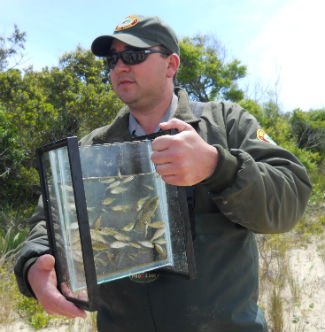 Justin Barnes, a ranger at Jockey’s Ridge State Park, holds up an aquarium he used for fish caught in a seine net. The fish were later released. Photo: Corinne Saunders Justin Barnes, a ranger at Jockey’s Ridge State Park, holds up an aquarium he used for fish caught in a seine net. The fish were later released. Photo: Corinne Saunders |
NAGS HEAD —
The first group came sprinting down the final sand dune on the back side of Jockey’s Ridge, so eager to begin they literally couldn’t contain themselves.
Group after group of eighth-grade students from First Flight Middle School completed the roughly 15-minute hike from the museum at Jockey’s Ridge State Park to the edge of the sound on Friday, May 3, where they dispersed to various leaders waiting along the shore.
They were about to spend 2.5 hours doing restoration work and hands-on learning about the diverse ecosystem surrounding them.
The sun shone and the wild spring wind was mostly blocked by the dunes.
I had traveled to the site minutes before with Park Ranger Justin Barnes in the park-owned Polaris—a four-wheel-drive all-terrain vehicle sometimes used to transport handicapped visitors or dignitaries to the top of the dunes.
Supporter Spotlight
Also riding in the Polaris were Dewey Hemilright, a commercial fisherman of 25 years based out of Wanchese; and Rhana Paris, the outreach coordinator at the N.C. Aquarium on Roanoke Island.
My three travel companions all led groups of students in specific explorations, as did N.C. Coastal Federation staff members and other volunteers.
The school has close to 200 eighth-grade students. “It took us three days to get them all out,” said Sara Hallas, a regional educator for the federation.
Sixty eighth-graders were bused to Jockey’s Ridge May 3.
The Nature Conservancy, Jockey’s Ridge State Park, N.C. Aquariums and Jennette’s Pier, the National Oceanic and Atmospheric Administration’s Monitor National Marine Sanctuary, Hemilright and other volunteers helped the federation over the three days.
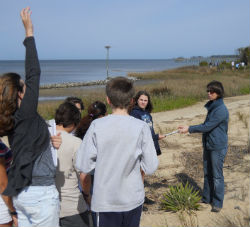
Erin Fleckenstein, right, talks about a yucca plant with some eighth-graders at First Flight Middle School. Photo: Corinne Saunders |
Erin Fleckenstein, coastal scientist and the manager of the federation’s Northeast Region office in Manteo, explained the need for restoration work to two curious passers-by. She told them how the nearby Villa Dunes subdivision had, in the 1970s, begun expansion plans by removing all the nearby vegetation and even creating a roadbed before Carolista Fletcher Baum led the charge 40 years ago to create a state park.
In 2009, restoration work began. Grant funding was provided by the U.S. Fish and Wildlife Service, the NOAA’s collaboration with the Southeast Aquatic Resources Partnership, the Carlson Family Foundation and the Albemarle-Pamlico National Estuary Program.
Project partners are Jockey’s Ridge State Park, N.C. Coastal Federation, The Nature Conservancy and the N.C. Division of Marine Fisheries.
They used recycled Christmas trees and sand fencing to build mini-dunes, then built an oyster reef in the nearby shallow sound water, Fleckenstein said. Oysters clean the water by filtering it, and oyster reefs encourage new oyster growth.
Once the sand and water were more stabilized, they planted marsh grass in between.
As Fleckenstein told a group of students later, “sand fencing helps slow down the sand so it doesn’t suffocate our marsh grass.”
More marsh grass will be planted in coming months, but it is still growing in a greenhouse now, Hallas said.
Students focused on repairing mesh bags full of recycled oyster shells the first two days and invasive plant removal on this final day, Hallas explained.
The oyster reef is hundreds of bags of oyster shells stacked in a row, with a break in the reef every 100 feet so water can come in and out.
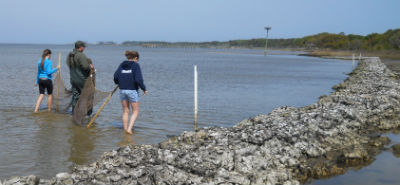
Two students help Park Ranger Justin Barnes with the net in a catch-and-release activity to study local fauna. |
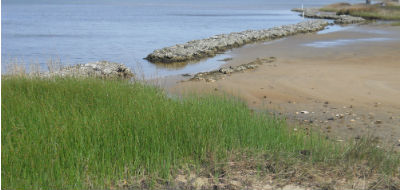
Marsh grass was planted in between the oyster reef and the shore as part of restoration work. Photos: Corinne Saunders |
A football team from up north on alternative spring break and local eighth-graders helped in the initial phase of the reef, forming a human chain and passing bags to be stacked to create the reef, said Aaron McCall, northeast region steward for The Nature Conservancy.
Now the focus is reef maintenance.
Bill and Frances Smyth, volunteers who live in the Alligator River area, helped with the day’s project of invasive plant removal. The focus was rattlebox, a non-native species that spreads rapidly.
The Smyths participate in such federation projects in part to learn about preserving shoreline and native plants, so they can translate the knowledge to how they maintain their own property, Frances said. They also like the young leadership of the federation, she added.
Ernest Boyce, another volunteer, also helped with rattlebox removal. He saw the project on the federation calendar and took time off from his work at East Carolina University so he could help.
“This is my first time hands-on helping them,” Boyce said. “I’m trying to do more than just write a check.”
McCall spoke to his group of students about oyster reef ecology. The oyster reef is home to baby flounder, trout, eel, striped mullet, crab and shrimp. He took a bag from the reef and shook it above sand to show students a variety of these creatures before placing them back in the water.
As the students saw baby eel twisting in his palm and juvenile crabs scuttling toward the water, even those who had been reluctant to become involved were gripped with enthusiasm.
Barnes, meanwhile, was leading a catch-and-release program nearby. Taking a seine net, he caught shrimp, baby croaker and other fish near the oyster reef. He put the catch in a small clear aquarium for the students to study up close before returning the animals to the sound.
Hemilright has partnered with Hallas in a school program called Provider Pals. He gives a presentation to students explaining “if we don’t have clean water, we don’t have seafood.”
He showed his group a sword his buddy crafted from a swordfish bill, as well as mako and dusky shark jaws.
“Look at the rows of teeth,” he pointed out. As soon as one falls out or breaks off, another in a long line-up of back-up teeth within the jaw replaces it.
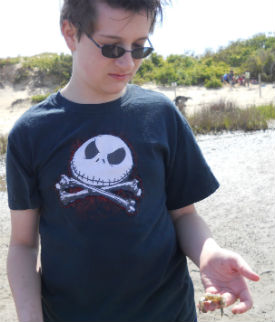
Paul Seyler studies a baby crab he found in the oyster reef. Photo: Corinne Saunders |
Paris spoke to her group about lunar-driven ocean tides and wind-driven sound tides. The wind had blown the sound out today, but she pointed to the visible high-tide line.
Paris explained the sound is brackish water—a mix of saltwater and freshwater. She led the students in testing the sound’s pH, which turned out to be a neutral seven; DO (dissolved oxygen), which was seven or eight parts per million; and nitrates (nitrogen), which was two.
Paris noted it is desirable to have a low nitrates reading, but good there is a high DO, since fish breathe the oxygen in the water.
Hallas told me her students completed a runoff matching activity. When I arrived at her group, they were categorizing plastic animals by species and figuring out which were marine mammals and why. They were also deciding which marine mammals could be seen locally, such as river otters and bottlenose dolphin.
Fleckenstein’s group sketched flora of their choice. As I approached, I heard her tell a student she drew a yucca plant, which will have white flowers in the summer. “You guys are great scientific observers,” she said.
Every so often, the groups would switch, allowing the students to participate in a variety of fun, educational experiences.
I asked three students what they had learned.
“I learned about all the different plants, saw all their vibrant colors, and you can eat some of them,” said Natashia Moore. “But I didn’t, because people step on them and animals poop on them.”
“I learned how the marsh is important and how it cleans out the water,” said Kayli Martin. “We think it is a poopy thing but it actually helps clean.”
Morgan Brinkley agreed. “A lot of people think it’s just the marsh, but it’s really helpful to where we live.” She also liked “how they use natural things to protect it.”
It seems the oyster reef behind Jockey’s Ridge has become a thriving natural habitat, and also an effective outdoor classroom.








